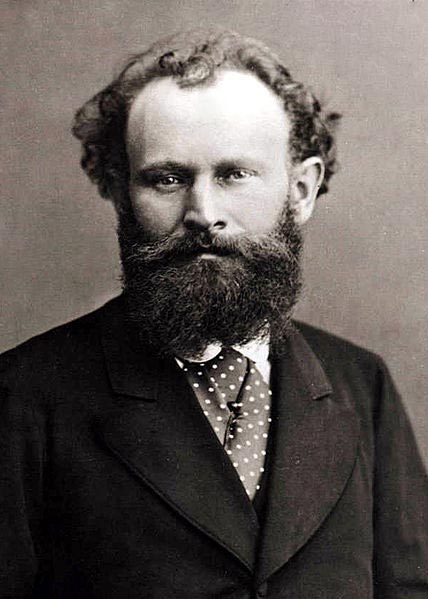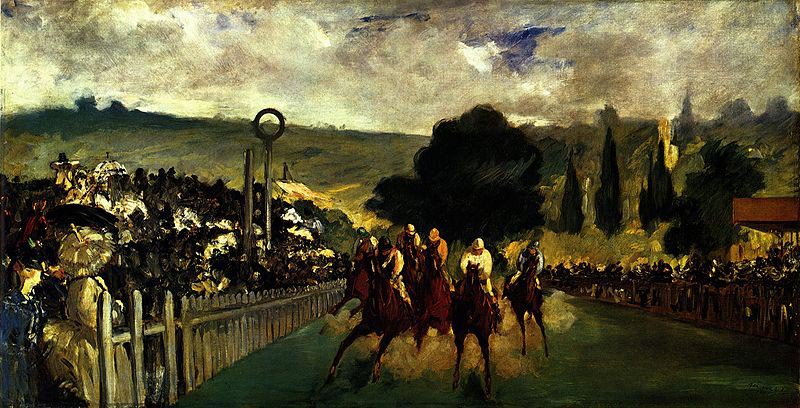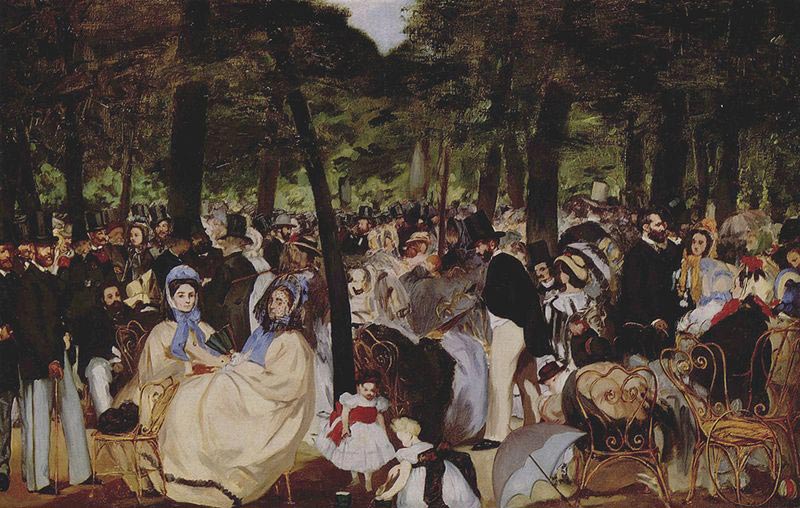| Édouard Manet | |
|---|---|
 |
|
| Born | Jan. 23, 1832 Paris, France |
| Died | Apr. 30, 1883 (aged 51) Paris |
| Nationality | French |
| Education | Thomas Couture |
| Movement | Realism, Impressionism |
| Field | Painting, printmaking |
| Famous Paintings by Manet | |
| Le déjeuner sur l’herbe | |
| Olympia | |
| Nana | |
| A Bar at the Folies-Bergère | |
| The Balcony | |
| The Fifer | |
| The Railway | |
| The Spanish Singer | |
| The Old Musician | |
| Complete Works |
Édouard Manet was born on January 23 of 1832 in Paris, France. His father was Auguste Manet, who worked at the Ministry of Justice, and his mother was Eugénie-Désirée Fournier. In 1839, he went to school at Canon Poiloup in Vaugirard and studied French and the classics. He went to Collège Rollin in 1844. In a year, his interest was only in drawing courses. His father didn’t allow Édouard to be a painter, instead he wanted him to be a lawyer but Édouard refused. Édouard also took an entrance examination for naval college, but he failed twice so his father gave in to his son’s desire to paint.
In 1850, Édouard joined the studio of a classical painter named Thomas Couture and after six long years, Édouard was able to set up his studio which he shared with a painter named Albert de Balleroy. He painted “The Boy with Cherries” in 1858 and “The Absinthe Drinker” in 1859.
Édouard also encountered a poet named Charles Baudelaire who suggested Édouard to paint the “Concert in the Tuileries Gardens” in 1862. As he was painting his work, many passersby watched with much curiosity at him elegantly dressed while he would start painting his canvases in the open air. Then, in 1861 at the Salon, Édouard exhibited the Spanish Singer.
From 1862 to 1865, Édouard participated in exhibitions prepared by the Martinet Gallery. In 1863, Édouard met and married Suzanne Leenhoff, who was a Dutch woman that taught him the piano and gave him a child before marriage.
In 1865 one of his paintings, called Olympia, which was created two years ago, brought about a scandal. It was a painting with the use of oil on canvas. This created scandal because they judged it as a painting which displays immorality.
 Having several of his works being rejected from the 1967 Universal Exposition, Édouard stood up a stall at the corners of Avenue Montaigne and Pace de l’Alma. There, he exhibited some of his works involving his paintings of bullfights and toreadors. He exhibited about a maximum of 50 of his paintings. A young novelist named Émile Zola, who was impressed by Édouard’s naturalism of work, made an article in which he praised Édouard for his passion in painting. Édouard then thanked Zola and as a sign of gratitude, Édouard made a portrait of Zola that was exhibited at the Salon on 1868. Along with it, Édouard also exhibited “The Balcony”. A French Impressionist woman named Berthe Morisot became a frequent visitor at Édouard’s studio. Édouard painted portraits of Morisot who was then married to his brother, Eugène Manet.
Having several of his works being rejected from the 1967 Universal Exposition, Édouard stood up a stall at the corners of Avenue Montaigne and Pace de l’Alma. There, he exhibited some of his works involving his paintings of bullfights and toreadors. He exhibited about a maximum of 50 of his paintings. A young novelist named Émile Zola, who was impressed by Édouard’s naturalism of work, made an article in which he praised Édouard for his passion in painting. Édouard then thanked Zola and as a sign of gratitude, Édouard made a portrait of Zola that was exhibited at the Salon on 1868. Along with it, Édouard also exhibited “The Balcony”. A French Impressionist woman named Berthe Morisot became a frequent visitor at Édouard’s studio. Édouard painted portraits of Morisot who was then married to his brother, Eugène Manet.
From 1870 to 1871, during the German-Franco War, Édouard Manet served as one of the National Guard’s staff deputy and attested Paris siege. And in February 1871, he went home to his family, but returned to Paris before the Commune. He saw his studio half-destroyed, but he had stored his canvases in a safe place. An art dealer named Paul Durand-Ruel bought nearly everything in Manet’s studio, paying 50,000 in francs. In year 1872, he went to the Netherlands where he was influenced by Frans Hals’ work. As a result, Édouard painted Le Bon Bock (“The Good Pint” 1873), which was a great success at the Salon’s exhibition in 1873.
In 1874, Édouard developed a close friendship with a young Impressionist named Claude Monet. Édouard painted “Boating” which depicted 2 figures seated under the sun in a certain boat. He also painted “Monet Working on His Boat in Argenteuil” in 1874.
In 1877, Édouard was inspired by the lady of demimonde when painting the art “Nana”. He also painted “The Plum” which was considered one of his key artworks. In “The plum”, a lonely woman rests her thin elbows on a marble top of a certain café table. Along with this, he also painted “The Blonde with Bare Breasts” in 1878 and “Chez le Pere Lathuille” which was yet another one of his major works (created on 1879 as well). From then on, Édouard did several numbers of pastels. He took George Moore under his wing in 1879. Moore was an Irish future painter and novelist who frequently joined Edgar Degas and Manet at Café Nouvelle-Athènes.
 In 1880, Eduardo had an exhibition at the periodical La Vie modern, but unfortunately, his legs were affected by a problem that seemed to be fatal. In April 6th of 1883, after painting lilacs and roses, Édouard took to his own bed. Gangrene had developed in his left leg. Not long after, he died and was buried in Passy’s cemetery.
In 1880, Eduardo had an exhibition at the periodical La Vie modern, but unfortunately, his legs were affected by a problem that seemed to be fatal. In April 6th of 1883, after painting lilacs and roses, Édouard took to his own bed. Gangrene had developed in his left leg. Not long after, he died and was buried in Passy’s cemetery.
In the January of 1884, a post-mortem exhibition of Édouard’s work was held at the Salle de Melpomène of École des Beaux-Arts. With great respect for Édouard, Zola wrote the prologue to a catalog. It was after this commemorative exhibition that Édouard’s paintings began to achieve prominence.